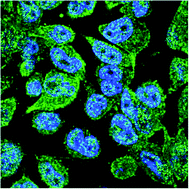ADAMTS13 is a secreted zinc metalloprotease expressed by various cell types. Here, we investigate its cellular pathway in endogenously expressing liver cell lines and after transient transfection with ADAMTS13. Besides compartmentalizations of the cellular secretory system, we detected an appreciable level of endogenous ADAMTS13 within the nucleus. A positively charged amino acid cluster (R-Q-R-Q-R-Q-R-R) present in the ADAMTS13 propeptide may act as a nuclear localization signal (NLS). Fusing this NLS-containing region to eGFP greatly potentiated its nuclear localization. Bioinformatics analysis suggests that the ADAMTS13 CUB-2 domain has a double-stranded beta helix (DSBH) structural architecture characteristic of various protein–protein interaction modules like nucleoplasmins, class I collagenase, tumor necrosis factor ligand superfamily, supernatant protein factor (SPF) and the B1 domain of neuropilin-2. Based on this contextual evidence and that largely conserved polar residues could be mapped on to a template CUB domain homolog, we hypothesize that a region in the ADAMTS13 CUB-2 domain with conserved polar residues might be involved in protein–protein interaction within the nucleus.

